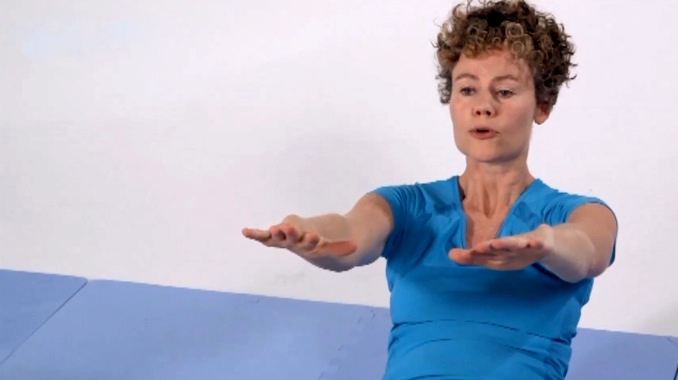Curl Downs Vs. Sit-Ups
Have you ever noticed that when your alarm goes off in the morning, it’s almost as if your body instinctively knows to curl up and contract?
That same instinctive movement – of curling down into a ball – is also what we use when doing crunches or sit-ups.
Free Posture Crash Course!
Discover the crazy, simple 3-step formula that will teach you how to improve your posture and flexibility like a pro. You will learn how to hardwire the habit of good posture, reduce forward head and the secret way to stop slouching. It's 100% free!
But which exercise offers more benefits: curl downs or sit-ups?
As a posture doctor, I’m here to give you the scoop on these two exercises and how they can help improve strength and flexibility. By comparing them side by side, we’ll be able to see exactly which one gives us better results from our workouts!
Curl Downs
Curl downs, also known as abdominal curls, are a form of exercise designed to strengthen the core muscles. They target the rectus abdominis muscle group in particular and can be done with or without weights.
To do a curl down, you begin by lying flat on your back. With feet firmly planted on the ground and arms resting beside you, engage your core muscles while lifting your upper body off the floor until it’s nearly vertical.
Hold this position for several seconds before slowly returning to the starting point.
Curl downs require no equipment beyond what is typically available in most home gyms; just a mat and enough space to lie down comfortably. As such, they make an ideal addition to any fitness program looking for an effective way to build strength in the abs.
Sit-Ups
Sit-ups: the exercise that everyone loves to hate.
Despite its difficulty, sit-ups are an incredibly effective way of toning your abs and strengthening your core.
So what is a sit-up?
It’s pretty simple really; you lie on your back with your knees bent and feet flat on the floor. Then, using your abdominal muscles, you lift yourself up until your elbows touch your knees and lower yourself back down again.
That’s one rep!
As well as working out the entire abdominal region, they also target other areas such as the chest, shoulders, and hips.
Benefits Of Curl Downs
Curl downs are an effective exercise that can help to strengthen the abdominal muscles. They involve lying flat on your back and using a barbell or other weighted object to curl up towards your chest, then slowly returning it to its starting position. This type of exercise targets not only the abdominal muscles but also the hip flexors and obliques.
Curl downs have several benefits compared to sit-ups.
Firstly, they require less effort than traditional sit-ups as you don’t need to lift your legs off the floor whilst performing them.
Secondly, curl downs put significantly less strain on your lower back as there’s no need for full body extension when executing them; this makes them ideal for those with existing lower back issues who still want to work their core area.
Finally, because curl downs isolate the abdominal muscles more accurately than sit-ups, users may find that they engage their abdominals more effectively during each rep which ultimately leads to faster results in terms of muscle definition and tone.
In short, curl downs offer an excellent alternative way of targeting specific areas of your abdomen without putting unnecessary stress on other parts of your body – making them a great choice for anyone looking to enhance their core strength and stability.
Benefits Of Sit-Ups
Sit-ups are often thought of as the go-to exercise for abs, but they have a lot more to offer than just toned abdominal muscles. Not only do sit-ups help strengthen your core and improve balance and posture, but they also work to increase endurance and flexibility in other parts of the body.
To illustrate their importance, imagine that you’re going on a hike or lifting heavy weights. In both cases, you need strong abdominal muscles to keep your torso upright and protect against injury. Sit-ups give those muscles the strength and stability needed for such tasks:
Core Strength:
- Improved Balance & Posture: Strengthened abdominals make it easier to stay balanced when walking up hills or doing any type of standing activity. They also promote better posture when sitting down at work or during leisure activities like playing video games.
-
Increased Endurance: Regularly performing sit-ups helps build stamina so you can last longer in physical activities without tiring out quickly.
Flexibility:
- Enhanced Range of Motion: Doing sit-ups regularly increases mobility in the hips, shoulders, and spine which is beneficial for sports performance and everyday movement.
- Reduced Risk of Injury: The improved range of motion provided by sit-ups reduces the risk of strains or sprains while exercising because your joints will be able to move properly with greater ease.
The benefits associated with sit-ups are clear—from helping prevent injuries to improving overall fitness levels—making them an essential part of any workout routine.
Different Types Of Curl Downs
A great abdominal exercise to add to the mix of sit-ups is curl-downs. Curl downs are a type of ab workout that can be done with or without equipment, offering a variety of options for different fitness levels.
When executed properly, curl downs provide an intense core strengthening regimen that targets all areas of the abdomen: upper abs, lower abs, and oblique muscles. To perform this exercise correctly, you must keep your back flat against the floor throughout the entire movement.
| Exercise | Benefits |
|---|---|
| Hanging Leg Raise | Works hip flexors & strengthens upper abdominals |
| Cable Crunch | Targets deep muscle fibers in lower abdominals |
| Reverse Crunch | Improves posture by engaging glutes & spine |
These exercises include hanging leg raises from a pull-up bar, cable crunches on a machine, reverse crunches lying on the floor or using an incline bench.
Each exercise has its own unique benefits when it comes to targeting various parts of the abdominal region.
For example, hanging leg raises work the hip flexors and strengthen the upper abdominals while cable crunches target deeper muscle fibers located in the lower section of the abdominals.
Reverse crunches help improve posture by engaging both glutes and the spine as well as building up strength in those tricky midsection muscles.
No matter what type of curl down you choose to do, proper form is key to getting the maximum benefit out of these types of workouts. Be sure to check your technique with each rep and avoid arching your back or letting your feet touch the ground during any set – this will ensure that you’re doing each move correctly and safely!
Different Types Of Sit-Ups
Ah, sit-ups. The exercise of choice for those who want to become the next fitness guru or just look good in their clothing. But what type of sit-up should you be doing? Let’s take a deep dive into the different types so you can make an informed decision!
- Traditional Sit-Ups: These are your classic abdominal exercises that require you to lie on your back and lift up your torso until it is perpendicular to the floor. This is great for working out your core muscles and strengthening them.
- Crunches: A crunch is similar to a sit-up but involves less movement; instead, you only move your upper body off the ground while keeping your lower body still. They’re perfect if you don’t have much space or time as they target more specific areas than regular sit-ups do.
- Bicycle Crunches: If you want even more targeted ab work, try bicycle crunches! You start by lying flat with one leg bent at a 90-degree angle near your chest and the other leg extended straight out. Then alternate bringing each knee towards your chest while twisting from side to side with each rep – this really works those obliques!
How To Properly Perform A Curl Down
Curl downs are an effective way to work the core muscles, and they offer a variation on traditional sit-ups.
To begin a curl down, start by lying flat on your back with your legs straight out in front of you and your arms at your sides, palms facing up.
Next, slowly raise both arms so that they reach above your head toward the ceiling. When you do this, be sure to keep your elbows slightly bent and avoid locking them or arching your lower back.
Once you’ve reached full extension, pause for a moment before curling yourself forward into a sitting position using only the strength of your upper body. Your feet should remain planted firmly on the floor throughout the entire exercise. Make sure that you maintain control as you move through each repetition; don’t rush it because proper form is key!
This will ensure that you get the maximum benefit from the movement while avoiding any potential injury. With regular practice, curl-downs can help build strong abdominal and arm muscles without putting too much strain on other areas of the body.
How To Properly Perform A Sit-Up
Sit-ups are excellent exercises for developing core strength and can be done almost anywhere. To do them correctly, you must first understand the proper technique.
| Step | Description | Tips |
|---|---|---|
| 1 | Lie on your back with your knees bent and feet flat on the floor. Place hands behind the head or across the chest. | Make sure to keep your lower back pressed into the ground throughout the entire movement. |
| 2 | Curl up until shoulders raise off of the floor while keeping neck neutral (not straining it). Reach straight forward towards toes if desired. | Keep abs engaged as you curl up; focus on using abdominal muscles instead of momentum from legs/arms. |
| 3 | Slowly return to starting position without letting your head touch the ground in between each repetition. | Do not bring your chin all the way down to your chest; this will put a strain on your neck. |
For best results, aim for 15 repetitions per set and complete at least three sets during a workout session. Additionally, ensure that you breathe steadily throughout the motion for a smooth flow of energy and maximum benefit from this great ab exercise!
Muscles Used For Curl Downs
Curl downs are like the more relaxed younger brother of sit-ups. Unlike sit-ups which require strong abdominal muscles, curl-downs target the lower back and hip flexors. These exercises are an easy way to stretch out tight muscles in those areas, while still providing a challenging workout.
The primary muscle used for curl downs is the rectus abdominis. This large muscle runs along both sides of your torso and helps provide support when you’re sitting up or standing straight. The obliques and transverse abdominis also help with support during this exercise. Additionally, your glutes, hamstrings, and quadriceps assist in performing the movement correctly.
Muscles Used For Sit-Ups
Sit-ups are a great way to strengthen the core muscles of your abdomen. When performing a sit-up, you use your rectus abdominis muscle and several other muscles in your torso. The rectus abdominis is the large muscle that runs along the front of your abdomen from your sternum down to your pubic bone—it’s commonly referred to as the “six pack” or “abs” muscle. Other important muscles used during sit-ups include: external obliques, internal obliques, transverse abdominis and hip flexors.
The external obliques are located on either side of the abdominal wall and help with rotation and side-bending movements. They also assist in stabilizing the spine when completing a sit-up movement. The internal obliques lie beneath the external ones, helping with trunk rotation and lateral flexion (side bending).
Lastly, the transverse abdominis wraps around our midsection like an inner corset providing support for all major lifts while also giving us stability throughout everyday activities. Additionally, hip flexors work together with our abs to bring our legs up towards our chest during a sit-up motion.
All these muscles working together form what many people call their ‘core’ strength – which plays an essential role in nearly every exercise we do!
Modifications And Variations
Like a bolt of lightning, curl downs and sit-ups will have you feeling the burn in no time! While both exercises are great for toning your core muscles, there are several modifications and variations that can make them even more challenging.
Curl downs can easily be modified to target different muscle groups. For example, if you want to focus on your lower abs, hold a weighted ball between your feet while performing the exercise. You can also add an extra challenge by adding resistance bands or ankle weights during the movement.
Alternatively, widening your arms slightly wider than shoulder-width apart as you perform each rep will engage additional abdominal muscles.
Sit-ups can also be varied depending on what type of results one is trying to achieve. To increase difficulty levels and further tone up those abs, adding a weight plate across the chest or holding onto dumbbells during each rep is sure to do the trick.
If targeting obliques is desired then bent leg twists with a medicine ball would be ideal for this purpose. Additionally, keeping legs straight throughout reps instead of bending them at 90 degree angles may help strengthen deeper core muscles like transverse abdominis which helps provide stability when exercising other body parts.
These modifications and variations offer endless possibilities for anyone looking to take their ab workouts up a notch – so why not give them a try?
Safety Tips For Performing Exercises
Safety while exercising is always of utmost importance. Whether you are doing curl-downs or sit-ups, it is important to take the necessary precautions to avoid any injuries.
Here are some tips for safely performing exercises:
- Warm up – Before starting your exercise routine, make sure to warm up by stretching and light jogging for 5 minutes. This will help prepare your body for the workout ahead.
- Use proper form – To get the most out of your workouts and prevent injury, make sure to use good form when performing exercises such as squats, curls downs, or sit-ups. A personal trainer can be especially helpful in this regard so that you understand how to correctly perform each movement with correct form and alignment.
- Listen to Your Body – It’s important not to push yourself too hard during a workout; if something feels off or uncomfortable then stop what you’re doing and rest until the feeling passes. By listening to your body, you’ll ensure that you don’t overwork yourself or strain any muscles unnecessarily.
Exercising requires dedication but also caution in order to stay safe while reaching our fitness goals. Taking these steps into consideration before starting an exercise routine will help minimize the risk of injury and maximize results!
Equipment Needed For Each Exercise
For a curl down, all one needs is their own body weight as resistance. A mat can be useful for comfort, but it’s not absolutely necessary; many people do them on the floor or even in bed.
When doing sit-ups, however, more gear might be needed depending on the goals of the individual. To start off with basic form and technique, no additional items are necessary.
But if higher-intensity workouts are desired then weights or an exercise ball could come into play. A sturdy wall can also provide great support when performing this type of abdominal workout too.
In short, both exercises require minimal resources–just your commitment and willpower! With proper form and dedication to each move, anyone can strengthen their core muscles in no time at all.
Comparison Of Effectiveness And Efficiency
| Exercise Type | Targeted Area | Efficiency | Effectiveness |
|---|---|---|---|
| Curl-Downs | Lower Abdominals | More efficient | Less effort required |
| Sit-Ups | Entire Abdominals | Less efficient | More energy required |
- Both exercises are effective for abdominal muscles, but differ in terms of efficiency and targeted area.
- Curl-Downs are more efficient at targeting the lower abdominals, require less effort and can be performed quickly.
- Sit-Ups are less efficient, but target both upper and lower abdominals, require more energy, and have a greater range of motion, making them more effective.
- If looking for a fast, low-effort exercise with some benefit, curl-downs may be best.
- For an intensive workout with maximum benefit in a shorter amount of time, sit-ups are likely the way to go.
Recommended Frequency For Each Exercise
Curl downs and sit-ups are two of the most common abdominal exercises. While they may appear to be similar, there is a difference in how often each should be performed for optimal results. According to a study published by the American Council on Exercise, curl-downs are more effective when done three times per week while sit-ups can safely be done every day.
For those looking for an efficient abdominal workout routine, incorporating both curls downs and sit-ups into their plan can help achieve desired results quickly.
Doing 3 sets of 15 repetitions of curl downs combined with 2 sets of 20 reps of crunches will give you an effective full ab workout. Remember that consistency is key; performing these exercises consistently over time will yield the best results!
Is your ab workout hurting your back?
Traditional sit-ups are a great way to cause disc bulging, herniations, and ‘pinched nerves’ that can lead to sciatic leg pain and visual posture changes in your body.
Your lower back can only take so many repetitions of crunching before the discs begin to degenerate and wear.
Try this instead:
Further Resources: Posturecise (Level 1) – How to Create a Daily Posture Habit for Life




